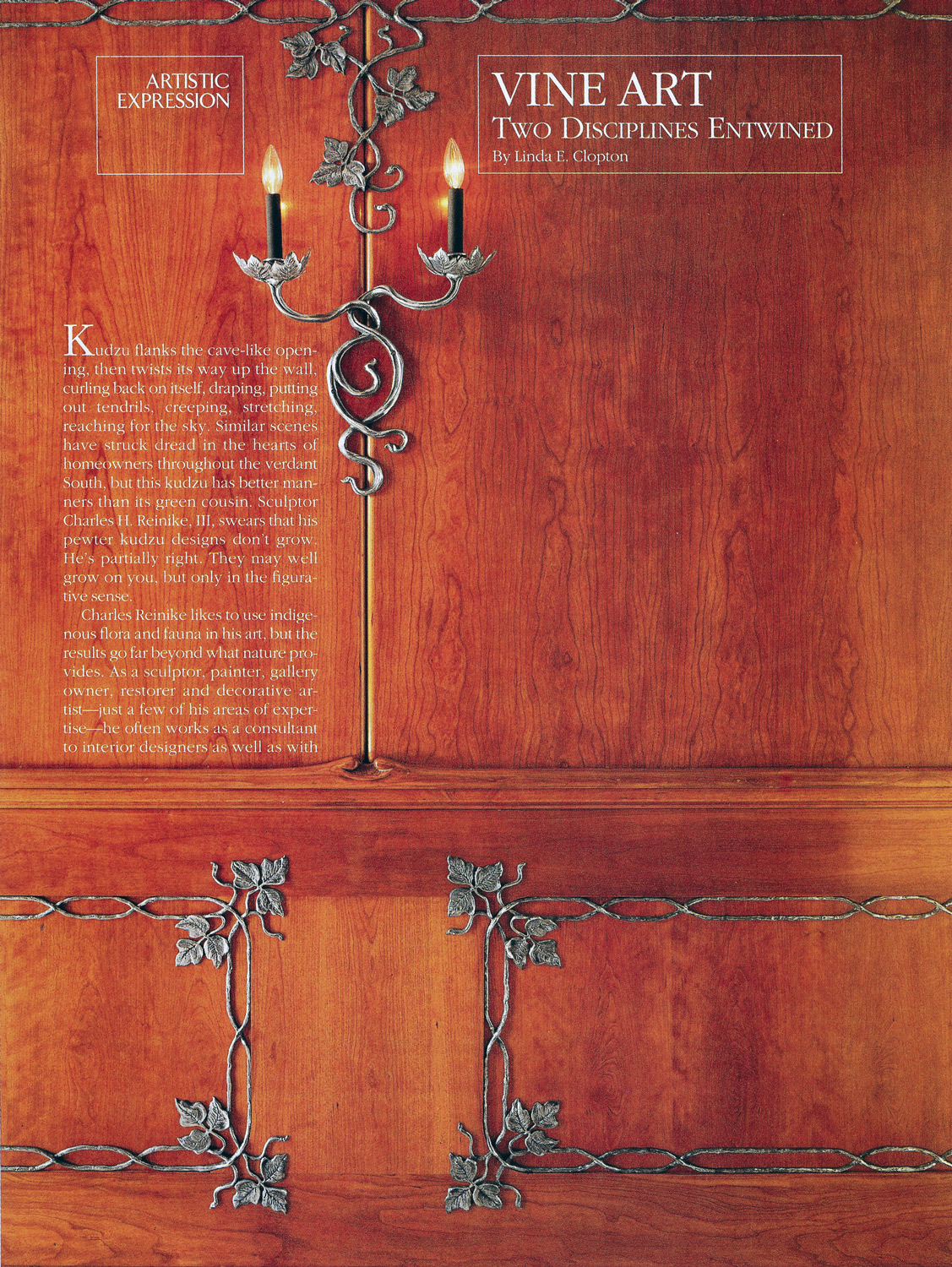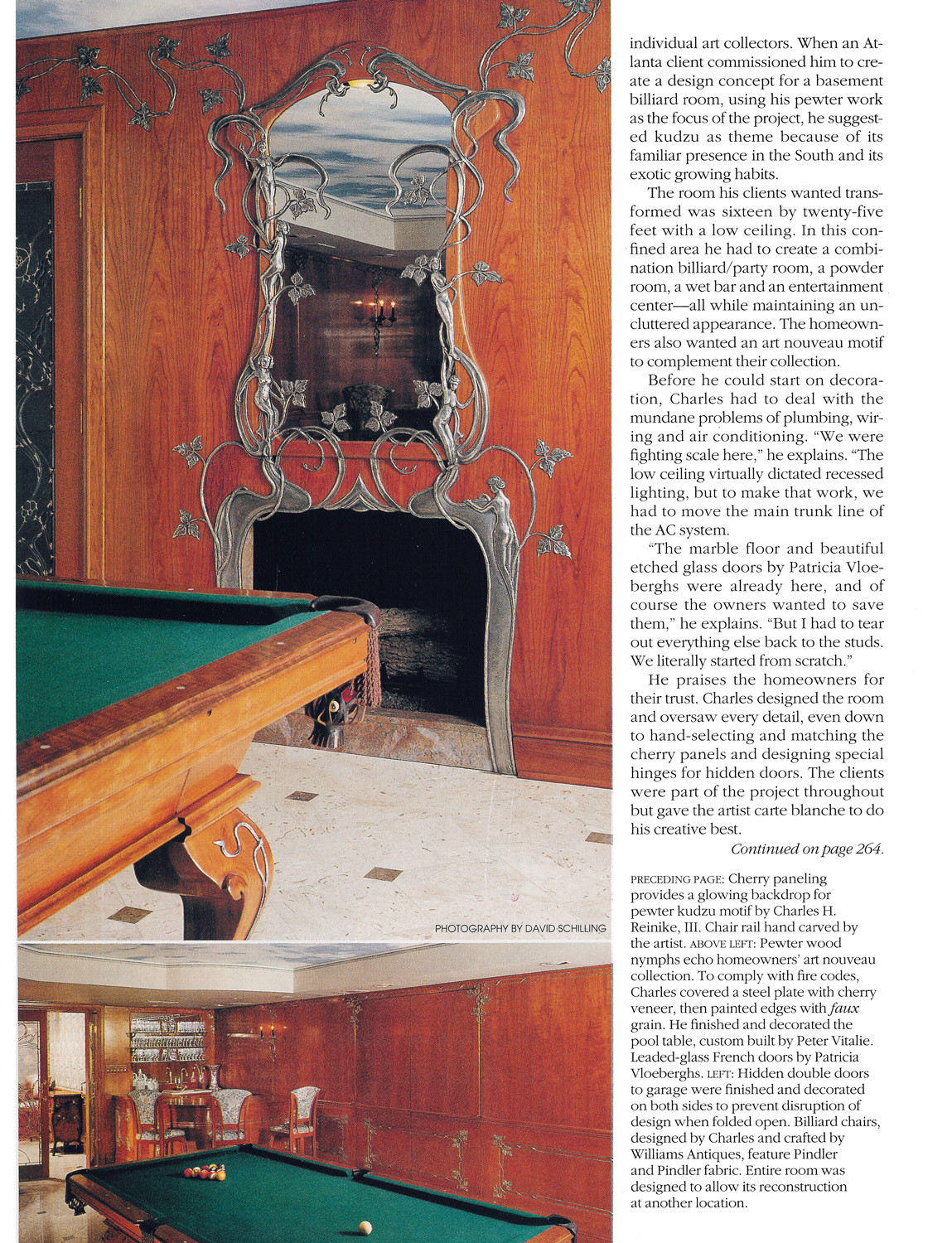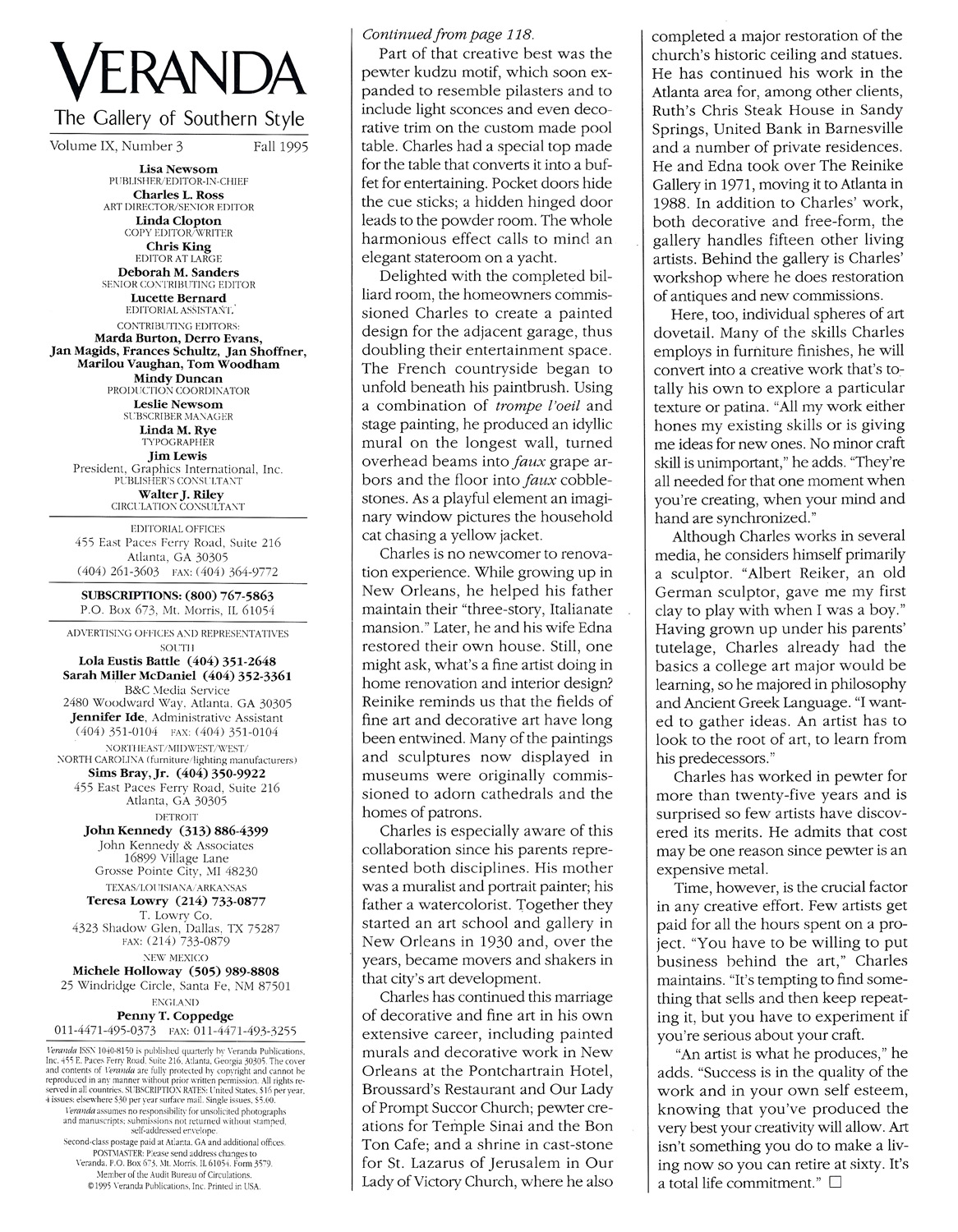Vine Art
Two Disciplines Entwined
- by Linda Clopton -
Veranda Magazine

Kudzu flanks the cave-like opening, then twists its way up the wall., curling back on itself, draping, putting out tendrils, creeping, stretching, reaching for the sky. Similar scenes have struck dread in the hearts of homeowners throughout the verdant South but this kudzu has better manners than its green cousin. Sculptor Charles H. Reinike III swears that his pewter kudzu designs don't grow. He's partially right. They may well grow on you, but only in the figurative sense.
Charles Reinike likes to use indigenous flora and fauna in his art, but the results go far beyond what nature provides. As a sculptor, painter, gallery owner, restorer and decorative artists - just a few of his areas of expertise - he often works as a consultant to interior designers as well as with individual art collectors.

When an Atlanta client commissioned him to create a design concept for a basement billiard room, using his pewter work as the focus of the project, he suggested kudzu as theme because of its familiar presence in the South and its exotic growing habits.
The room his clients wanted transformed was sixteen by twenty-five feet with a low ceiling. In this confined area he had to create a combination billiard/party room, a powder room, a wet bar and an entertainment center-all while maintaining an uncluttered appearance. The homeowners also wanted an art nouveau motif to complement their collection.
Before he could start on decoration, Charles had to deal with the mundane problems of plumbing, wiring and air conditioning. "We were fighting scale here," he explains. "The low ceiling virtually dictated recessed lighting, but to make that work, we had to move the main trunk line of the AC system.
" The marble floor and beautiful etched glass doors by Patricia Vloeberghs were already here, and of course the owners wanted to save them," he explains. "But I had to tear out everything else back to the studs. We literally started from scratch."
He praises the homeowners for their trust. Charles designed the room and oversaw every detail, even down to hand-selecting and matching the cherry panels and designing special hinges for hidden doors. The clients were part of the project throughout but gave the artist carte blanche to do his creative best.
PRECEDING PAGE: Cherry paneling provides a glowing backdrop for
pewter kudzu motif by Charles H. Reinike, Ill. Chair rail hand carved by the artist. ABOVE LEFT: Pewter wood nymphs echo homeowners' art nouveau collection. To comply with fire codes, Charles covered a steel plate with cherry veneer, then painted edges with faux grain. He finished and decorated the pool table, custom built by Peter Vitalie. Leaded-glass French doors by Patricia Vloeberghs. LEFT: Hidden double doors to garage were finished and decorated on both sides to prevent disruption of design when folded open. Billiard chairs, designed by Charles and crafted by Williams Antiques, feature Pindler
and Pindler fabric. Entire room was designed to allow its reconstruction
at another location.

Part of that creative best was the pewter kudzu motif, which soon expanded to resemble pilasters and to include light sconces and even decorative trim on the custom made pool table. Charles had a special top made for the table that converts it into a buffet for entertaining. Pocket doors hide the cue sticks; a hidden hinged door leads to the powder room. The whole harmonious effect calls to mind an elegant stateroom on a yacht.
Delighted with the completed billiard room. the homeowners commissioned Charles to create a painted design for the adjacent garage, thus doubling their entertainment space. The French countryside began to unfold beneath his paintbrush. Using a combination of trompe l'oeil and stage painting, he produced an idyllic mural on the longest wall, turned overhead beams into faux grape arbors and the floor into faux cobblestones. As a playful element an imaginary window pictures the household cat chasing a yellow jacket.
Charles is no newcomer to renovation experience. While growing up in New Orleans, he helped his father maintain their "three-story, Italianate mansion." Later, he and his wife Edna restored their own house. Still, one might ask, what's a fine artist doing in home renovation and interior design? Reinike reminds us that the fields of fine art and decorative art have long been entwined. Many of the paintings and sculptures now displayed in museums were originally commissioned to adorn cathedrals and the homes of patrons.
Charles is especially aware of this collaboration since his parents represented both disciplines. His Mother was a muralist and portrait painter; his father a watercolorist. Together they started an art school and gallery in New Orleans in 1930 and, over the years, became movers and shakers in that city's art development.
Charles has continued this marriage of decorative and fine art in his own extensive career, including painted murals and decorative work in New Orleans at the Pontchartrain Hotel, Broussard's Restaurant and Our Lady of Prompt Succor Church; pewter creations for Temple Sinai and the Bon Ton Cafe; and a shrine in cast-stone for St. Lazarus of Jerusalem in Our Lady of Victory Church, where he also completed a major restoration of the church's historic ceiling and statues. He has continued his work in the Atlanta area for, among other clients, Ruth's Chris Steak House in Sandy Springs, United Bank in Barnesville and a number of private residences. He and Edna took over The Reinike Gallery in 1971, moving it to Atlanta in 1988. In addition to Charles' work, both decorative and free-form, the gallery handles fifteen other living artists. Behind the gallery is Charles' workshop where he does restoration of antiques and new commissions.
Here, too, individual spheres of art dovetail. Many of the skills Charles employs in furniture finishes, he will convert into a creative work that's totally his own to explore a particular texture or patina. "All my work either hones my existing skills or is giving me ideas for new ones. No minor craft skill is unimportant," he adds. "They're all needed for that one moment when you're creating, when your mind and hand are synchronized."
Although Charles works in several media, he considers himself primarily a sculptor. "Albert Reiker, an old German sculptor, gave me my first clay to play with when I was a boy." Having grown up under his parents' tutelage, Charles already had the basics a college art major would be learning, so he majored in philosophy and Ancient Greek Language. "I wanted to gather ideas. An artist has to look to the root of art, to learn from his predecessors."
Charles has worked in pewter for more than twenty-five years and is surprised so few artists have discovered its merits. He admits that cost may be one reason since pewter is an expensive metal.
Time, however, is the crucial factor in any creative effort. Few artists get paid for all the hours spent on a project. "You have to be willing to put business behind the art," Charles maintains. "It's tempting to find something that sells and then keep repeating it, but you have to experiment if you're serious about your craft.
"An artist is what he produces," he adds. "Success is in the quality of the work and in your own self esteem, knowing that you've produced the very best your creativity will allow. Art isn't something you do to make a living now so you can retire at sixty. It's a total life commitment."